Years ago when I worked in hospitals and rehab facilities physicians would sometimes explain to patients my role by saying the Physical Therapist would get them back to 100% and I would get them to 110%. Part of me would bristle whenever I would hear this because I felt that it really didn't express the reality of what patients understand. Getting back to 100% sounds like a very good goal and, I felt, that for many it would be seen as enough of a goal. After all, getting back to "normal" after going through an injury or surgery is exactly what most want.
The 100% though, fails to consider that it is often the "normal" that caused the problem in the first place. The percentage makes it seem as if the patient is back to whole when in reality the patient is back to the same place with the same issues and the only difference is less acute pain. All of this assumes that the cause was biomechanics - either abuse, misuse or disuse. The last of the 4 possible causes is trauma and that is the only one that is not due to progressive body movement patterns. For the other 3 causes, at 100% the stage is still set for problems to occur and this is typically not what one tends to think when they are injured and working to getting back to normal.
As I said, I used to not like this percentage comment but over the years I have begun to understand that it is a simple way to attempt to explain a topic that is not easily grasped. The complexity of how the body moves can be easily overlooked by the fact that it does move.
If you are not having pain then there is little priority in addressing how your body moves. This is the reason that rehab practices, from orthopedic to cardiac, often have trouble keeping patients focused on maintaining their treatments once the immediacy of the pain is relieved. As long as you are able to carry on your normal daily activities then that is the priority and there is not motivation to consider how your body is moving.
How you move determines the amount of wear that your joints are taking and from my perspective, holds a higher priority than what you do. While it is true that there is no substitute for movement, the way in which you move determines the benefit as well as the potential damage. Learning how your body moves provides you with the ability to choose dependent on what your priority is at the time. Sometimes very simple changes can make a big difference.
As always, let me know how I can help.
Adam

 RSS Feed
RSS Feed
